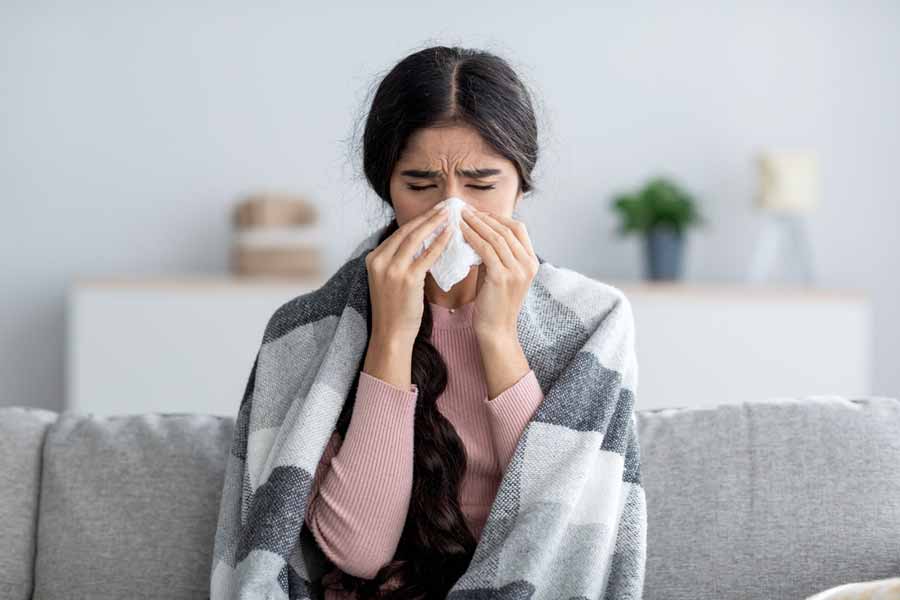Given the rising number of respiratory infections with the coming of winter, discover the main differences between COVID-19 and influenza.
TecSalud infectious disease specialist Dr. Gloria Aguirre explained that other diseases are doing the rounds too, such as the respiratory syncytial virus (RSV) and rhinovirus, which have shown an upward trend in the last few weeks.
“If you have already come down with a viral respiratory infection, make sure your COVID and influenza vaccines are up to date; having been infected does not exempt you from reinfection from other strains,” she warned.
CONECTA reveals the main differences between COVID and influenza.

What’s the difference between COVID and influenza?
Dr. Aguirre listed the main differences between COVID and influenza.
“Influenza can be differentiated from the COVID-19 Omicron variant and other infections that cause the common cold, such as rhinovirus and RSV, by the sudden manifestation of symptoms, high-grade fever, severe body aches, joint pain, and severe headaches.”
Sudden onset commonly occurs from one day to the next along with a fever of at least 38-39 degrees.
“(In the case of influenza) your general state of wellbeing comes under siege: body aches, joint pain, and muscle pain. Nasal congestion may be experienced. Coughing is not so frequent,” she said.
COVID-19 usually comes on more gradually.
“(With COVID-19) I have a sore throat one day and the next day I have congestion. And the day after that I start feeling weaker, and so on.”
She said that fever is one way of telling the two diseases apart.
“Fever is usually more common in influenza, and it is a higher grade of fever. Also, there is much more extreme fatigue. People complain a lot about aches and pains.
In the case of COVID, the fever is not so high and its symptoms, in general, are:
- A sore throat that causes dryness and itching
- Mild fever
- Runny nose
- Sneezing
- Mild to moderate fatigue
- Headache
Higher number of cases during winter months
The specialist mentioned that, according to Ministry of Health epidemiology reports, positive PCR testing for COVID-19 stands at 14% nationwide.
However, the numbers of cases are much lower as compared to previous years, with significantly less impact on hospitalizations and deaths from COVID-19.
The specialist mentioned that transmission of influenza and respiratory syncytial virus has become more common during recent weeks and is on a par with COVID-19.
“Even the number of hospitalizations from influenza pneumonia exceeds COVID for 2023-2024.”
Dr. Aguirre said that although there has been an increase in the number of cases of viral respiratory infections, most have not required hospitalization.
“In the case of COVID-19, the number of cases and hospitalizations have been much lower in comparison with previous years.
“Compared to pre-pandemic and pandemic years, the number of influenza cases in the last two seasons has been higher.”
“Compared to pre-pandemic and pandemic years, the number of influenza cases in the last two seasons has been higher.”
Main precautions: face masks and vaccinations
The infectious disease specialist suggested the use of masks and vaccinations as general prevention measures.
“Mainly, wear masks in enclosed or poorly ventilated places to prevent transmission.”
She suggested completing the full course of vaccinations to reduce the risk of complications such as pneumonia.
The main vaccinations include those for COVID, influenza, RSV, and pneumococcus. Consult your doctor to review and optimize your vaccination program.
Also, keep as safe a distance from others as possible and wash your hands regularly with alcohol solutions and/or soap.
Finally, the specialist recommended getting tested if you have symptoms or if you have been exposed to someone with COVID-19 or the flu.
On another note, the infectious disease specialist warned that quick tests for influenza have a sensitivity of 50 to 60%.
“If a quick test gives a negative result, don’t rule out the possibility of having influenza,” she said.
“If you have already been sick with a viral respiratory infection, make sure your COVID and influenza vaccinations are up to date; having been infected does not exempt you from reinfection.”

What should I do if I become infected?
- Stay in quarantine for five to seven days until the symptoms disappear.
- Always wear a face mask.
- Follow your doctor’s indications and don’t self-medicate.
- Monitor your oxygenation with an oximeter.
Dr. Aguirre pointed out that most cases involve the upper respiratory tract. This, in addition to the fact that a large part of the population has already been vaccinated or infected, means that the prognosis of most cases is mild.
Seek urgent medical attention if...
- You have difficulty breathing.
- Your oxygenation level is below 90%.
YOU MAY ALSO LIKE TO READ:





